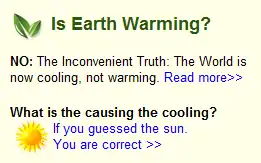CO2 is Green
CO2 is Green, along with its sister organization Plants Need CO2, is a global warming denialist pressure group in the United States which lobbies against the classification of carbon dioxide as a pollutant. These organizations argue that since carbon dioxide is a vital chemical for plant life, more of it can only be a good thing, and that any reduction in CO2 output would be harmful to the ecosystem and the economy.
| It's gettin' hot in here Global warming |
 |
| Feverish dreams |
| Hot-headed goons |
v - t - e |
This is analogous to saying that blood is good for you as it supports your body's critical functions, so you should be in favor of having gallons of blood forcibly injected into your veins. The idea that we should be pumping CO2 into the atmosphere is seen as complete and utter nonsense by anyone with any experience or knowledge of ecology, atmospheric chemistry and climate change.
Background
Unsurprisingly, the CO2 is Green and Plants Need CO2 groups are the creation of the fossil fuel industry: specifically Leighton Steward, retired vice chairman of Burlington Resources oil and gas company, and Corbin J Robertson Jr, chief executive of Natural Resource Partners, a coal resourcing corporation, both based in Houston, Texas.[1] Plants Need CO2 is a 501(c)(3) non-profit organization, which classifies them as a charity and makes donations tax-deductible,[2][3] while CO2 is Green is a 501(c)(4) organization, meaning contributions are not tax-deductible and that the organization is allowed to engage in lobbying and similar activities.
CO2 is Green, with its aim of "educating" the public on the alleged dangers of reduced carbon emissions, has launched newspaper and television advertisements in several states.[4] The TV ads feature a montage of aesthetically-chosen nature film footage and a soothing voiceover affirming that "higher CO2 levels than we have today would help the earth's ecosystems and support more plant and animal life."[5]
The CO2 website urges readers to write to their Senator, Congressman, and the Senate Committee on Environment and Public Works, protesting against the classification of CO2 as a pollutant.
Debunking time
There are two central claims made by the CO2 is Green pressure group: firstly, that carbon dioxide is not a pollutant, and secondly that more of it will make the world better. Both are very wrong; at best they are simplifications of real science and twisted semantics; at worse, they are outright fraudulent claims.
Not a pollutant
The adverts claim that "there is no scientific evidence that CO2 is a pollutant." Of course, there is plenty of scientific evidence to show the effects of carbon dioxide on the atmosphere. The definition of a "pollutant", however, is a complicated issue to address, and as we all know, complicated issues are a veritable playground for people with an agenda.
If we define a pollutant as something actively and instantly harmful, carbon dioxide is not a pollutant. If we define it as something that can cause serious environmental problems and destabilize natural systems when present in elevated concentrations, it certainly is a pollutant. We suspect that CO2 is Green are playing around with their definitions when they make this claim. The nature and activity of a pollutant depends on concentration, bioaccumulation, and other factors — even the most harmful substances in the world have little or no effect in sufficiently small doses, while even some of the most benign can be devastating in high doses. The simple facts are that carbon dioxide is known to be a greenhouse gas,[6] and there's a hell of a lot of it that's out there now that wouldn't be if we hadn't burned millions of years' worth of carbon fixation in the form of fossil fuels.
More carbon dioxide is good

That's right folks, the sun is cooling the earth! (Quick, use lots more carbon fuels before it's too late!)
The second claim — that more CO2 will benefit the world — has absolutely no backing in reality. In the case of CO2, it's not that the molecule itself is a dangerous pollutant or actively harmful, but rather that high concentrations of it have a much different effect than low concentrations. CO2 may be "plant food" in the basic, Sunday school version of how carbon cycles around the Earth, but this emphatically does not mean that more is better. It's true that in a broad sense, more CO2 will tend to increase plant growth, but it doesn't affect all plants equally. Most worrisome, while crop species like extra CO2, it turns out that weeds absolutely love extra CO2. The result is that the tendency for extra CO2 to increase weed growth can negate the benefits of extra CO2 for some crops that are deemed as more important,[7] though the weed used in the experiment (common amaranth
Soil nutrients also tend to be a long-term limiting factor in the the growth rates of plants per land area, and any short-term benefit from excess CO2 is quickly lost as nitrates, phosphates, and other essential nutrients for growth are permanently consumed[8].
Moreover an increase in atmospheric concentration will accelerate the greenhouse effect, warming the planet, and plants will hardly be in need of all this extra food if they're all dying because the climate is changing too quickly. Some corollaries:
- Vitamin C is definitely good for you, but eating your own weight in oranges will just cause the body to excrete the excess. In the worst-case scenario you could overdose on the substance and suffer very ill effects as the body can't keep up removing it at a fast enough pace.[9]
- In a more relevant example, mammals do need a small amount of carbon dioxide in their blood. This can be found in the blood around muscle tissue and, due to the changes in pH by the presence of carbonic acid, displaces oxygen from hemoglobin. Without the carbon dioxide there, oxygen wouldn't unload out of the blood and into the cells and respiration would not occur — CO2 is good for you! In higher concentrations, however, carbon dioxide stays loaded onto hemoglobin and its presence in the blood causes oxygen to be loaded onto hemoglobin less efficiently.
- Everybody needs food, but one of the greatest health problems in modern Western societies is consuming too much food.
- Also, do you know that you can actually overdose on water? Classified as dilutional hyponatremia (or "water intoxication"), it was utilized as a form of torture as early as the Middle Ages.[10]
Plants are not the only sink for carbon dioxide. Most of it is permanently stored by being dissolved in the oceans. As the oceans warm up, the solubility of gases goes down (this is the reverse situation of the solubility of solids – think of the explosive fizzing when you open a warm bottle of a soft drink). Thus as the oceans warm they can't absorb as much CO2 — so there'll be more of it in the atmosphere. More CO2 in the atmosphere leads to more warming, and the cycle continues in a positive feedback loop.
Colour
Of course, the main problem is that carbon dioxide is transparent. Like the CO2 is Green agenda, one might say.
When ionised, it glows a nice blue-white or pink colour, which is almost the complete opposite of green.[11]
See also
- Ron Johnson - A U.S. Senator who has pushed this line of "thought."
- Center for the Study of Carbon Dioxide and Global Change, who love CO2 just as much
- Global warming conspiracy theory
External links
- CO2 is Green
- Plants Need CO2
- Center for the Study of Carbon Dioxide and Global Change
- CO2 is plant food, Skeptical Science
- The CO2 is plant food crock, Climate Denial Crock of the Week
References
- New Groups Revive the Debate Over Causes of Climate Change, Washington Post September 25, 2009.
- See statements on both organisations' websites, as linked above.
- Oil & Coal Interests Launch "CO2 Is Green" Misinformation Campaign, Media Matters
- CO2 is green: the TV advert making viewers choke,The Guardian, 28 September 2009.
- CO2 is Green video
- We've known this 1859, starting from the laboratory experiments of John Tyndall. See here for a nice summary of the historical development of the topic.
- Ziska, L.H., 2000: The impact of elevated CO2 on yield loss from a C3 and C4 weed in field-grown soybean. Global Change Biology 6, 899-905.
- Soil nutrients may limit ability of plants to slow climate change
- According to the Mayo Clinic, symptoms of excess Vitamin C intake can include diarrhea, vomiting, insomnia, and kidney stones.
- See the Wikipedia article on Water cure.
- Pretty.